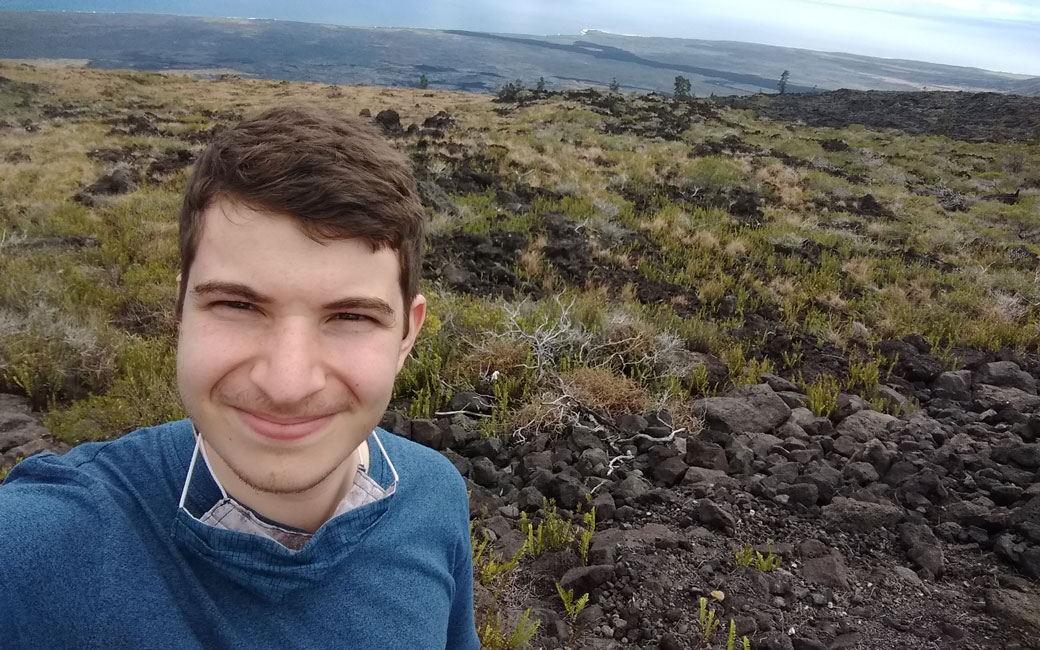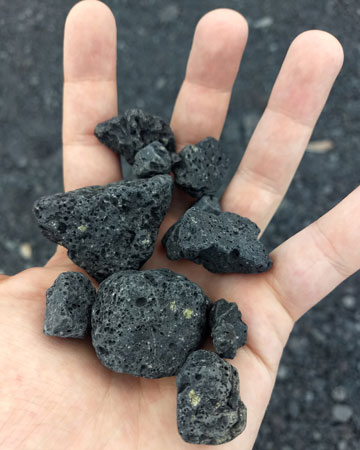Recent grad’s research could have effects on how we study Mars’ surface
David Hislop traveled to Hawaii to compare its sand to Mars’
By Kyle Hobstetter on June 26, 2022

Ever since he was in middle school, David Hislop wanted two things. He wanted to study rocks and he wanted to go to Towson University.
Hislop was able to achieve both of these goals, as the Crofton, Md., native graduated this past spring from Towson University, earning a bachelor's degree in geology.
Hislop admitted he was like most geologists: the proud owner of his own rock collection while in middle school. One day after school, he went on the computer and looked up what careers focused on dealing with rocks.
There he found out about becoming a geologist, and he also discovered Towson University’s geosciences program.
“I was always fascinated by rocks, and I wanted to learn about their whereabouts, their intricacies and details,” Hislop says. “The TU professors in the geology department are incredible. Every single professor in the geology department is an expert. And they are so knowledgeable and they are so willing to help students in this field.”
At Towson University, Hislop was able find a mentor who shared his passion: Wendy Nelson, Ph.D., an associate professor of geosciences in TU’s Department of Physics, Astronomy and Geosciences.
Like many faculty members, Nelson was looking for students to help with various research projects she was working on. After having Hislop in a couple of classes, she invited him to get involved.
“In the classroom, David was detail oriented and he always asked really good questions,” Nelson says. “You can tell the gears were always turning in his head and he was really good at making connections.”
The internship planets align
While he was making connections in the classroom, Hislop was also working on making connections off-campus as well. This included sending emails to the Smithsonian, looking for research opportunities.
Through a collective effort of his family, classmates and himself, he found a hundred-page document of every person who worked at the Smithsonian. That document had their email as well as a small biography of what they do.
Through that, he found the Center for Earth and Planetary Studies within the National Air and Space Museum, and then took a shot by sending an email to everyone in the Center who might be doing geological research.
“I’ve been told that if you send a direct email, you’ll be much more likely to receive and email back,” Hislop says. “With an internship program, you’re grouped with hundreds, if not thousands, of other students looking for that same opportunity.”
Hislop heard back from Bob Craddock, a geologist at the Smithsonian National Air and Space Museum and is affiliated with the Center for Earth and Planetary Studies.
Craddock has been conducting a study that “combines remote sensing data, quantitative geomorphic analyses and terrestrial field investigations to help unravel the early geologic history of Mars and to better understand the processes that have shaped the surfaces of other planets.”
Finding Mars in paradise
Over the past year, Hislop has been one of the students helping Craddock with the study, where he’s been able to study surface matter from around the earth similar to those found on Mars.
“There are places such as Iceland and Arizona that have these mafic compositions that are very similar to the surface of Mars,” Hislop says. “And the region that I’m looking at is in Hawaii, specifically in the Kaʻū Desert. We see there's a lot of basaltic sediments, but basalt is a clear indication of a mafic environment. So, the conditions are very similar.
“If we could take a handful of [sand] samples, could we determine two things. One, where did it come from? Two, how long did it take to get there.”
Through his work, Hislop was able to work with both Craddock and with Nelson to create his own research project, titled “Exploring Basaltic Sand Dunes in Hawaii as an Analogue for Sand Dunes on Mars.”
Craddock sent samples to TU, and with the help of another geosciences professor Andrew Hawkins, Ph.D., Hislop took photographs and measured the chemical composition of sand grains using TU’s Scanning Electron Microscope (SEM). He studied them and then shared his findings with Craddock and Nelson.
While there are instruments that can produce higher quality elemental analyses than the SEM, Hislop used the SEM because its resolution is similar to that the analytical equipment found on Mars rovers. If SEM data can be used to determine source and timing of sediment movement on Earth, the research team can recreate the study on Mars.

Reaching for the stars
To go along with his work on campus, Hislop and Nelson were invited to join Craddock and other members of Craddock’s Mars Analogue team in Hawaii in September of 2021 to study the sand of the Kaʻū Desert in person. Nelson used NSF funds (EAR award #1753748) to support work by the Towson group.
“This project is the result of David’s initiative,” Nelson says. “We [Craddock and Nelson] wanted to get him field experience. This was something in the United States, where they’re not going to shutdown borders [due to COVID-19]. With this project, he gets field experience with professionals and scientists from other universities, and it’s really good for his scientific development.”
In Hawaii, not only did David get to observe, but he was able to participate in field work for a major scientific project.
“I got to learn their methods going along, what they were doing and I got to participate in that,” Hislop says. “The trip was nothing short of life changing. Of course, there were ups and downs as with all kinds of field work. But I was gaining the experience, and that's what field work is like.
“This was one of, if not the best experiences of my life. I'm so lucky. And as I said, it's such a surreal experience, because this work could theoretically change the future of science and how we analyze extra-terrestrial grains, at least on Mars, but maybe for other planets as well.”
And all of these opportunities came because Hislop was assertive in trying to find the right research project that fit what he wanted to do with his professional career.
“I was able to go on this trip and I never forgot the fact that I was in Hawaii because I reached out to someone,” Hislop says. “They saw something in me and brought me along. It’s just been surreal.”